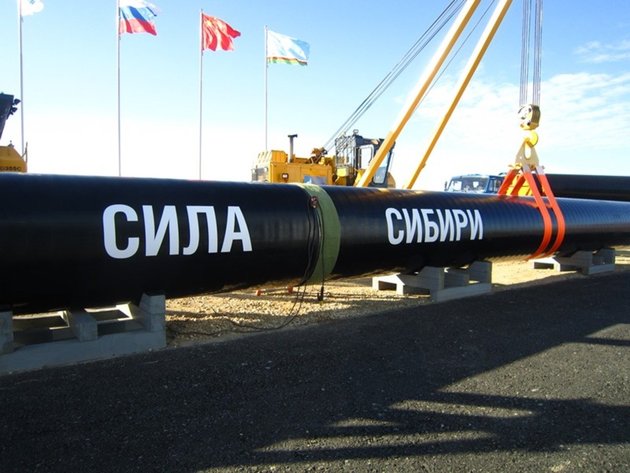The increasingly close relationship on multiple levels between Russia and China became obvious to anyone with an interest in such matters last July when the two countries staged their first joint air patrol in the Asia-Pacific region, sending the air and naval defences of the principal U.S. satellite countries in the area – Japan, South Korea, and the Philippines – into panic mode, Oil Price writes in the article Russia Races To Squeeze The U.S. Out Of Asian Natural Gas Markets.
At the same time, the two countries continue to push ahead with their game-changing US$400 billion ‘Power of Siberia’ gas project that will move at least 38 billion cubic metres of gas annually for 30 years from the Chayandinskoye and Kovyktinskoye fields in Eastern Siberia to Northeastern China. Last week saw major announcements from Russia that now that China is apparently past the peak of its coronavirus outbreak, plans for the project are moving quickly ahead and are being expanded in scope and scale.
As TS Lombard’s London-based China research team chairman, Jonathan Fenby, told OilPrice.com: “This political-economic nexus is set to bring growing divergence from the U.S. as part of the wider agenda of the ‘national strengthening’ being pursued by Xi Jinping, and Beijing is shifting from being an economic adversary to the U.S. to a geopolitical alternative and this could result in a step change in the nature of the confrontation between the two countries.” In both cases, the Power of Siberia project is perhaps the most tangible representation of this increasing economic and political congruence between the two countries.
Russia is looking to extend its leverage further in the shape of Nord Stream 2, the undersea Baltic gas pipeline to Germany, and the TurkStream pipeline to Turkey and Southern Europe. The Power of Siberia pipeline project fits into such a mould, although the initial focus is in undermining the U.S.’s geopolitical position in the Asia-Pacific, a broad strategic move that is thoroughly in line with China’s own plans for the area that it regards as its own backyard.
With the outbreak of the coronavirus, it is easy to forget that China was fully engaged in an all-out trade war with the U.S., and in this context the Power of Siberia pipeline can be used to edge out the U.S.’s gas supplies to the region as and when the need for an extra negotiating weapon arises. It would also add weight to China’s global geopolitical game-changing strategy implicit in its multi-generational ‘One Belt, One Road’ programme.
Russia, therefore, in the course of the last week, has stated that it is looking to increase both the flows through the Power of Siberia and the overall capacity (including storage) associated with these flows. Currently, the pipeline – in its eastern route - supplies gas from the Chayandinskoye field (the key element in the Yakutia gas production centre) to domestic consumers in Russia’s Far East and then on to China. According to Russia’s state gas giant, Gazprom, these commercial flows began last December at a rate of around 10 million cubic metres per day (cu m/d) towards an overall target rate of 38 billion cubic metres per year (Bcm/y).
To achieve this as quickly as possible, Gazprom stated last week, the Chayandinskoye field – discovered in 1983, with B1+B2 reserves of at least 1.2 trillion cubic metres of gas and about 61.6 million tons of oil and gas condensate – is now fully back on track following a two-week maintenance programme that was implemented to coincide with the force majeure on some import obligations declared in March by China’s PetroChina, due to the coronavirus outbreak. This is aimed at achieving the field’s annual design output of 25 billion cubic metres of gas ahead of schedule and specifically includes expanding the operating Comprehensive Gas Treatment Unit (CGTU) that feeds gas into the Power of Siberia pipeline and finalising the membrane unit for helium concentrate extraction (expected to come onstream in the next few months).
At the same time, Gazprom announced that it will complete the construction of the second compressor station on the Power of Siberia line before the end of 2020 and that it is to bring gas into the pipeline flow from the second major field involved in the project – Kovyktinskoye, the focus of the Irkutsk gas production centre – as from the end of 2022. Discovered in 1987, the Kovyktinskoye field holds the largest gas reserves in eastern Russia, with C1+C2 reserves across the licensed blocks (Kovyktinsky, Khandinsky, and Chikansky) containing 2.7 trillion cubic metres of gas and 90.6 million tons of gas condensate. Production drilling is now in full swing, according to Gazprom, with seven drilling rigs currently in operation but 18 in total planned for next year.
This will allow the company to export to China at least 5 Bcm of gas in the first year of operations through the Power of Siberia before the figure increases to at least 10 Bcm in the second year and the full capacity of 38 Bcm/y as from 2025. Linking the two key sites of Chayandinskoye and Kovyktinskoye will begin in the third quarter of this year with the construction of a new section of the Power of Siberia pipeline.
Alongside this, Gazprom is busy building out its storage capacity, last week announcing a target of more than 1 Bcm/d of withdrawal capacity by 2030. From 2010 to now, Gazprom has increased this amount that can be delivered from storage daily by 36 per cent, to 843 million cu m/d but plans to add a further 200 million cu m/d by the beginning of 2030, according to the firm. This will be achieved by expanding exiting storage facilities at the Kaliningradskoye and Volgogradskoye sites and the construction of a new facility at Shatrovskoye and other – as yet unspecified sites – in Tatarstan and the Northwestern, Siberian, and Far Eastern Federal Districts, Gazprom concluded.






